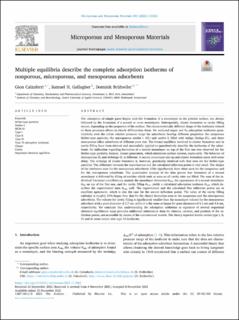Please use this identifier to cite or link to this item:
https://doi.org/10.21256/zhaw-23908| Publication type: | Article in scientific journal |
| Type of review: | Peer review (publication) |
| Title: | Multiple equilibria describe the complete adsorption isotherms of nonporous, microporous, and mesoporous adsorbents |
| Authors: | Calzaferri, Gion Gallagher, Samuel H. Brühwiler, Dominik |
| et. al: | No |
| DOI: | 10.1016/j.micromeso.2021.111563 10.21256/zhaw-23908 |
| Published in: | Microporous and Mesoporous Materials |
| Volume(Issue): | 330 |
| Issue: | 111563 |
| Issue Date: | 2022 |
| Publisher / Ed. Institution: | Elsevier |
| ISSN: | 1387-1811 |
| Language: | English |
| Subjects: | Stöber-type particle; Zeolite L; MCM-41; Type I; Type II; Type IV; Type VI; Adsorption isotherm; Cluster; Cavity; Sequential chemical equilibria |
| Subject (DDC): | 540: Chemistry |
| Abstract: | The adsorption of simple gases begins with the formation of a monolayer on the pristine surface, not always followed by the formation of a second or more monolayers. Subsequently, cluster formation or cavity filling occurs, depending on the properties of the surface. The characteristically different shape of the isotherms related to these processes allows to clearly differentiate them. We analyzed argon and N2 adsorption isotherms quantitatively over the entire relative pressure range for adsorbents bearing different properties: the nonporous Stöber-type particles, the microporous zeolite L (ZL) and zeolite L filled with indigo (Indigo-ZL), and three mesoporous silica adsorbents of different pore size. The formal equilibria involved in cluster formation and in cavity filling have been derived and successfully applied to quantitatively describe the isotherms of the adsorbents. No indication regarding formation of a second monolayer on top of the first one was observed for the Stöber-type particles. Instead, cluster generation, which minimizes surface tension, starts early. The behavior of microporous ZL and of Indigo-ZL is different. A second monolayer sets up and cluster formation starts with some delay. The enthalpy of cluster formation is, however, practically identical with that seen for the Stöber-type particles. The difference between the experimental and the calculated inflection points is very small. The shapes of the isotherms seen for the mesoporous adsorbents differ significantly from those seen for the nonporous and for the microporous adsorbents. The quantitative analysis of the data proves that formation of a second monolayer is followed by filling of cavities which ends as soon as all cavity sites are filled. The sum of the individual fractional contributions, namely the monolayer formation ΘmL, the appearance of a second monolayer Θ2L on top of the first one, and the cavity filling, yields a calculated adsorption isotherm Θcalc which describes the experimental data Θexp well. The experimental and the calculated first inflection points are in excellent agreement, which is also the case for the second inflection points. The value of the cavity filling enthalpy is roughly 10% larger than that for the cluster formation seen in the nonporous and the microporous adsorbents. The volume for cavity filling is significantly smaller than the monolayer volume for the mesoporous adsorbent with a pore diameter of 2.7 nm, while it is the same or larger for pore diameters of 4.1 nm and 4.4 nm, respectively. We conclude that understanding the adsorption isotherms as signature of several sequential chemical equilibrium steps provides additional information data for clusters, cavities, and position of the inflection points, not accessible by means of the conventional models. The theory reported herein covers type I, II, IV and to some extent also type VI isotherms. |
| URI: | https://digitalcollection.zhaw.ch/handle/11475/23908 |
| Fulltext version: | Published version |
| License (according to publishing contract): | CC BY-NC-ND 4.0: Attribution - Non commercial - No derivatives 4.0 International |
| Departement: | Life Sciences and Facility Management |
| Organisational Unit: | Institute of Chemistry and Biotechnology (ICBT) |
| Published as part of the ZHAW project: | Multimodal Porous Particles |
| Appears in collections: | Publikationen Life Sciences und Facility Management |
Files in This Item:
| File | Description | Size | Format | |
|---|---|---|---|---|
| 2022_Calzaferri-etal_Equilibria-description-adsorptions-isotherms.pdf | 5.74 MB | Adobe PDF |  View/Open |
Show full item record
Calzaferri, G., Gallagher, S. H., & Brühwiler, D. (2022). Multiple equilibria describe the complete adsorption isotherms of nonporous, microporous, and mesoporous adsorbents. Microporous and Mesoporous Materials, 330(111563). https://doi.org/10.1016/j.micromeso.2021.111563
Calzaferri, G., Gallagher, S.H. and Brühwiler, D. (2022) ‘Multiple equilibria describe the complete adsorption isotherms of nonporous, microporous, and mesoporous adsorbents’, Microporous and Mesoporous Materials, 330(111563). Available at: https://doi.org/10.1016/j.micromeso.2021.111563.
G. Calzaferri, S. H. Gallagher, and D. Brühwiler, “Multiple equilibria describe the complete adsorption isotherms of nonporous, microporous, and mesoporous adsorbents,” Microporous and Mesoporous Materials, vol. 330, no. 111563, 2022, doi: 10.1016/j.micromeso.2021.111563.
CALZAFERRI, Gion, Samuel H. GALLAGHER und Dominik BRÜHWILER, 2022. Multiple equilibria describe the complete adsorption isotherms of nonporous, microporous, and mesoporous adsorbents. Microporous and Mesoporous Materials. 2022. Bd. 330, Nr. 111563. DOI 10.1016/j.micromeso.2021.111563
Calzaferri, Gion, Samuel H. Gallagher, and Dominik Brühwiler. 2022. “Multiple Equilibria Describe the Complete Adsorption Isotherms of Nonporous, Microporous, and Mesoporous Adsorbents.” Microporous and Mesoporous Materials 330 (111563). https://doi.org/10.1016/j.micromeso.2021.111563.
Calzaferri, Gion, et al. “Multiple Equilibria Describe the Complete Adsorption Isotherms of Nonporous, Microporous, and Mesoporous Adsorbents.” Microporous and Mesoporous Materials, vol. 330, no. 111563, 2022, https://doi.org/10.1016/j.micromeso.2021.111563.
Items in DSpace are protected by copyright, with all rights reserved, unless otherwise indicated.